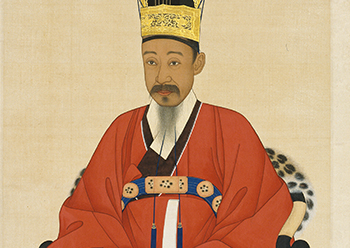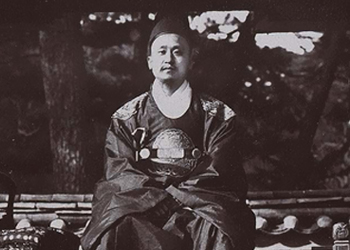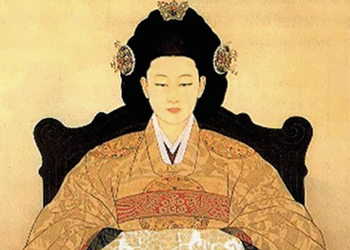
Heungseondaewongun was a royal family member and a politician of the Joseon Dynasty.
His nickname was Sibaek and penname was Seokpa while his real name was Haeung.
He was a fifth generation descendent of King Yeongjo and father of King Gojong the 26th king of Joseon Dynasty.
In 1843 (9th year of King Heonjong), he became Heungseongun. In 1846, he was promoted to Daejongwan of Sureungcheonjangdogam and then, appointed as Yusadangsang of Jongchinbu and Dochonggwan of Owidochogbu.
As the royal family experienced greater pressure from the power of the Andong Kim family, he pretended to be crazy, kept company with rogues, and became a beggar. He was jokingly called "Gungdoryeong", meaning 'green youth'. After King Cheoljong died without an heir, his second son, Myeongbok, was appointed king by the power of Queen Mother Jo and he himself became Daewongun. He reformed the government, rooted out nepotism, and hired anyone with talent regardless of their backgrounds through the regent. Also, he reformed the Seowons (private Confucius schools), which were reasons for political disputes. He reformed the tax system of "hwangok" to a "sachang" system to prevent tax benefits for the ruling class and to charge them the same gunpo that was charged to the commoners. He simplified the clothing and prevented lavish living on the part of the ruling elite. He established legal laws through his writings Daejeonhoetong, Yukjeonjorye, and Yangjeonpyeongo,but he also came under complaint by the people for levying heavy taxes and enlisting people to build Kyeongbok Palace.
He established a "swaegukyangi" policy that prohibited exchange with western powers. He executed nine French priests and 8000 Catholics in the year of Byeongin. This incident is called "Byeonginyangyo", which is the historical crackdown against Catholicism. The French army invaded the Joseon Dynasty because of this incident, but the Joseon Army destroyed the French battleships. Another incident, known as the "Battleship General Sherman" incident, with the U.S. trying to force the Joseon Dynasty to open its doors to the West. Although he eventually won this war as well, he lost political power due to an appeal on the part of Confucian scholars including Choi Ikhyeon, who was in a political power conflict with Queen Myeongseong. In 1882 (19th year of King Gojong ), an Imogunran (military coup) helped him to regain power, but with Qing Dynasty's intervention, he was exiled to Tianjin, China for three years. In 1886, he tried to put his eldest son, Jaemyeon, on the throne with the help of Wianseukai, an attempt which had failed. In 1895, he regained power again through the Eulmisabyeon that Japanese Ambassador Miura started. Afterwards, a pro-Russian government was formed through Aguanpacheon and so, he retired. In 1907 (1st year of King Sunjong), he was appointed as Dawwanwang. His appointed name was Heonui.
Yeoheungbudae (wife) Min (1818 ~ January 1898) was a royal family member of the Joseon Dynasty, the mother of King Gojong, and she was a daughter of Min Chigu.
She married Heungsondaewongun and with him, had two sons and one daughter. She was a Catholic from a young age and had read "Ilgwamun". In 1863, when her second son became king, she held a Catholic mass in Unhyeongung. In December 1863, she was invested with the title "Yeoheungbudae" (wife). In 1866, with her husband, Heungseondaewongun, were looking for a future queen for his son King Gojong and she recommended a daughter of Min Chirok, who was her uncle, and made her queen. Daewongun, considering the fact that Min Chirok's father died early, predicted that there would not be any future threat to the throne from his family - a view that was later radically changed by the adoption of a son by Min's brother, Min Gyeomho.
Min was baptized a Catholic by the French bishop, Mutel, in October 1887, when the Korea-France agreement was completed and Catholicism was allowed. She tried to protect the Joseon Dynasty from Russia, who had the ambition to conquer the Korean peninsula. Through the aid of the French government, her connection with her friend the French bishop, Berneux, and Gojong's nanny, Park Marta. In the end, she failed and in 1907, she received the investiture of "Sunmokdaewonbi.“

His name after death was Jaehwang whose childhood name was Myeongbok.
His Choja was Myeongbu Ja, Seongrim, and penname Juyeon. He was the second son of Lee Haeung (Heungseondaewongun), grandson of King Yeongjo, and his wife was Min, daughter of Chirok, Yeoseongbuwongun. In December 1863 (14th year of King Cheoljong), the king died without a successor and he became king at the age of 12 by the order of Queen Mother Jo. Too young to govern, the Queen Mother became regent. Under a great cause to help the King more efficiently, power was passed to Daewongun, which led to his decade-long administration.
For ten years of King Gojong's reign, his father, Heungseondaegun, carried out drastic reforms: getting rid of nepotism and divisive power structures between political scholars, hiring anyone with talent regardless of political backgrounds, abolishing Bibyeonsa, reviving the authority of Yijeongbu, establishing a strong military called Samgunbu, building an army, Yanghwajin, on the Han River to strengthen protection for the capital city, reforming taxation to make the ruling class pay their fair share, and punishing the ruling elites for the abuse of power . Daewongun's political missteps included a worsening national financial situation by extending Kyeongbok Palace, coining bad money, Dangbaekjeon, which led to the impoverishing of the commoner life, the enforced enlistment of physical labor from the commoners to build the palace which led to rioting, a crackdown on Catholicism, the killing of 8,000 Catholics, a closed door policy toward western powers, Byeoninyangyo (war against France), and Sinmiyangyo (war against the U.S). In November 1873 (10th year of Gojong), through Queen Min's conspiracy, he retired from political power and King Gojong became directly involved in governing. Afterwards, political powers were passed to Queen Min's family including Min Seungho, Min Gyeomho, and Min Taeho so nepotism began afresh.
The Unyoho Incident in 1875 forced the Joseon Dynasty to abandon its closed door policy to foreign countries. The Byeongja Agreement with Japan was made and a new culture and civilization of modern capitalist countries came to Joseon Dynasty. Conflicts between those that supported openness and those seeking to remain closed became more serious. In 1881, Joseonchaeryak, written by Hwang Junhyeon, was published, encouraging advocates of Pro-Confucian ideas (the Wijeongcheoksa faction) to raise their voice against the Min family government. Conspirators, including An Giyeong, sought to place Lee Jaeseon, Daewongun's first child born of a concubine, on the throne which was a plot that was uncovered by Go Byeon. The Min family government severely cracked down on the Wijeongcheoksa faction. In 1881, Sinsayurandan (diplomatic envoy) was dispatched to Japan to learn about the new Western civilization. The military was reformed and a new, western-style military called "Byeolgigun" was established. In 1882, strong opposition against the new military system started Imogunran (military coup), which caused bloody fighting between the pro-Western civilization (Gaehwapa) faction and those against it (Sugupa). In 1884, Gapsinjeongbyeon (political change in Gapsin year) forced King Gojong to move to Kyeongu Palace, and then to Gyedong Palace by Gaehwapa.
During this incident, King Gojong built diplomatic ties with the U.S. and Britain, but in 1885, the Tianjin Agreement, which removed the influence of Qing Dynasty in Joseon, gave power to Japan and provided a chance for Japan to colonize the Korean peninsula.
In February 1896, King Gojong and the crown prince escaped to the Russian Embassy through Weber's Plot (this incident is called "Agwanpacheon) and advocates looking to open Korea to the West, including Kim Hongji, Jeong Byeongha, and Eo Yunjong, whom were assassinated. A pro-Russian cabinet was put into place, placing Joseon under the protection of Russia. On February 25th, 1897, King Gojong moved to KyeonguPalace (present-day Deoksu Palace) according to an agreement between Russia and Japan. In August, he changed the name of the regal year to Gwangmu and, on October, changed the name of the Dynasty to Daehan, and became emperor. In 1904 (8th year of Gwang-mu), victorious in the Russo-Japanese War, Japan was able to establish the 1st Japan-Korea Treaty in which they requested in favor for Foreign Government. A year later, the rights of the public order of Korea were replaced by the Japanese Military Police and that same year in November, the Eulsa Treaty, which was the 2nd Japan-Korea Treaty, was made. The right to foreign policy was taken over by the Japanese and pushed the Korean nation into a state of national crisis, following the Soviet Invasion of Manchuria. Korean patriots Min Young-hwan, Jo Byung-sae, Hong Man-sik, and others protested through suicide, but in February of 1906, Japan put in place a Governor-General of Korea to fully implement Foreign Rule of Government. In 1907 at the 2nd Hague Convention in The Netherlands, King Gojong sent secret emissaries, Lee Jun and others, in hopes to regain Korea's rights. But due to Japan's obstruction, the mission resulted in failure and the entire "Hague Secret Emissary Affair" became ammunition for Japan to threaten the Emperor with abdication of his throne to Sun Jong.
It's said that after receiving the title of Former Emperor, he lived his later years in Duksoo Palace. In January 21st, 1919, he was said to been killed by poison by the Japanese. Gojong's 44 years of reign was a turbulent period for the Korean people and one in which he also experienced, the ill fate of the country and misfortune of losing his country after only 3 years of being on the throne. His royal tomb lies in Geumgok, Hongreung and he wrote the book "Juyonjib".

She was born in Yeo-heung as Yeosung Buwongun, Min Chi-rok's daughter (1851 ~ 1895).
At 8 years of age, she lost her father and suffered greatly as her family became impoverished, but amongst the Min family, she was known for being a precocious child. In 1866 (3rd year of Joseon's Gojong), Heungseon Daewongun sought to eliminate the power base that was built on nepotism surrounding the throne. At the recommendation of Daewongun's wife, Min, Daewongun's search for a suitable wife for his son, King Gojong, resulted in her becoming queen at age 16.
Although Gojong was in love with his courtesan, Lee, and cared little for Queen Myeongseong, Myeongseong was praised by those around her for her outstanding manners. When Courtesan Lee gave birth to a son, Wanhwa Gung, the child of a concubine, Heungseon Daewongun, Lee Ha-eung was very pleased. As a result, Queen Myeongseong, became motivated by feelings of discontent and jealousy to hone her political acumen. While Heungseon Daewongun ruled the country, the general public ignored Queen Myeongseong and she used this opportunity to gather the opposition to Heungseon Daewongun's power and to amass her own influence. In 1874 (Joseon's Gojong 11th year), she gave birth to Prince Chuk and the rise of Queen Myeongseong's party gained the notice of Heungseon Daewongun, causing him to make plans for Wanhwa Gung to be named the only successor to the throne. This plan was uncovered by Queen Myeongseong and started the beginning of a race for the throne. She sent Senior Lee Yu-won to Beijing in order to receive approval for Prince Chuk to be the successor. She took the opportunity of the civic unpopularity of Heungseon Daewongun's domestic policy and ordered Min Seung-ho to collude with Jo Sung-ha, nephew of Queen Jo, and with the Kim Byeong-kuk party, who opposed Heungseon Daewongun. She extended her power by allying with Heungseon Daewongun's oldest son, Lee Jae-myeon, and Heungseon Daewongun's older brother, Lee Choi-eung, as well as with Jo Doo-soon and Lee Yu-won. Finally in 1873 (the 10th year of Joseon Gojong), Heungseon Daewongun stepped down from his position and Gojong alone ruled the country.
Gojong created a Treaty of Peace and advocated an Open Door Policy for the country. He started to change the domestic affairs of Heungseon Deawongun from within. The main supporters of Queen Myeongseong gained position within the palace, resulting in an increased hostility with Heungseon Daewongun. This tension eventually led to a military rebellion in 1882, Imo year. Queen Myeongseong barely escaped to safety in the house of Chungju Mok. Min Eun-sik and Heungseon Daewongun was able to reclaim his position. He mistakenly believed that Queen Myeongseong had been killed in the event and even arranged a funeral for her, but Chinese intervention resulted in a limiting of the army and eventually the forced removal of Heungseong Daewongun to their country. After the 1884 Gapsin Coup, the Min clan forced out the Enlightenment Party and restored the balance of power to the conservative faction. Ten years later, pressure from Japan resulted in the Gabo Reform as Queen Myeongseong lost power again. Three countries intervened, putting Japan in an unfavorable position, and resulting in a partnership with Russia that threatened Japan's control. In September 1895, Miura was appointed as the Japanese Envoy after Inoue and he was set on a collision course with Queen Myeongseong and her partnership with Russia. The Myeongseong partnership with Russia irritated Japan and in October 8th, 1895, Queen Myeongseong was assassinated by a pro-Japanese group along with 20~30 men sent by the Japanese Envoy. Her corpse was wrapped in a royal blanket and dosed with gasoline before it was set aflame. This incident was called the Eulmi Incident. In the year 1897 (Korean Empire Gwangmu 1st), she was officially given the title Queen Myeongseong, and her remains were kept at South Cheongyangni until 1919, when King Gojong was dethroned, she was moved to Hongreung. Deep within Gyeongbok Palace near the Korean Folk Village (for a while the Jeonseung Craft Hall was used) on the right side, resides Queen Myeongseong's Memorial Tomb, alone throughout the years.
First generationLee Ha-eung (Heungseon Daewongun 1820~1898 Sunjo 20th~Gojong 35th)
2nd generationLee Jae-myeon (1845~1912)
Whanhyeong Gun Lee Jae-myeon was the first son of Hyeongseon Daewongun. Although he was seven years older than his brother Myeong-bok, he was not chosen to be the crown prince. After losing his wife, he remarried the 20-year-old, Gyesil, at age 57. Gyesil was 13 years younger than his son, Lee Jun-young.
3rd generationLee Jun-yong (1870~1917)
Youngsun Gun Lee Jun-yong was the first son of Lee Jae-myeon. He lived in Songjeong Sarang-Chae at the back of Norok Dang before moving to Unhyeongung. In 1896, right after the Eulmi Incident, he went to Japan to study modern sciences and returned to his home country after 12 years in 1908, after which he lived at Unhyeongung. In 1917, he passed away at age 47, 5 years after his father, Lee Jae-myeon's, death. Lee Jun-yong passed away without an heir. Lee Woo, who was son of King Uichin, the fifth son of Gojong, was chosen to be an adopted son. Lee (1883-1978), wife of Lee Jae-myeon, was intended to take care of the household of Unhyeongung, but Gyesil Gwangsan Kim of Lee Jun-yong, who was the granddaughter-in-law of Daewongun, managed all the housework.
4th GenerationLee Woo (1912~1943)
Huengyoung Gun Lee Woo was 5 years old when he was adopted by Lee Jun-yong. At age 10, he went to Japan and served in the Japanese Military. The sending of Lee Jun-yong and Lee Woo to Japan was part of a political propaganda. In Japan, Lee Woo married Pak Chan-ju (1914~1995), who was Pak Young-hyo's great-granddaughter.
5th GenerationLee Chung (1936~)
Lee Woo's eldest son, Lee Chung, is Heungseon Daewongun's 5th generation and Gojong's 4th generation descendant. Outwardly, his appearance show similarities to Gojong and he carries himself as a royal descendant should. Lee Chung grew up in Japan and did not live his childhood at Unhyeongung, but stayed there on occasional trips that were granted to Korea. Lee Chung became the owner of Unhyeongung in 1948. Difficulties in managing Unhyeongung resulted in the City of Seoul taking over management in 1993, and now, it is operating as the Capital of Seoul's 600-Year Anniversary Project.